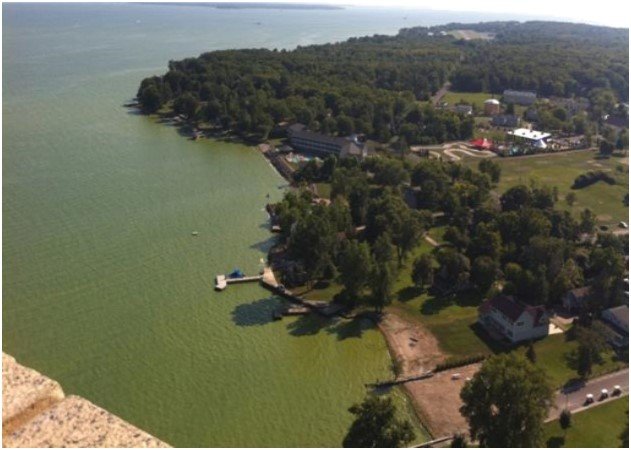Past Webinar Recordings 2024: Harmful Algal Blooms, Hypoxia, and Nutrients Research Webinar Series
Past Webinar Recordings
Harmful Algal Blooms, Hypoxia, and Nutrients Research Webinar Series
November 20, 2024: Health Effects and Ecology of Anatoxin-Producing Cyanobacteria
1. HABs: Toxicity and Health Effects of Anatoxin-A

This presentation will provide a research update on anatoxin health effects in mice from a toxicokinetic study and a 5-day oral exposure. The endpoints for the 5-day study include neurobehavioral and ototoxicity screening, effects on sperm count and testicular histopathology, ELISA’s for muscle injury and a protein associated with hearing loss, and serum metabolomic analysis. It will also discuss samples of liver and brain, which have been submitted for RNA transcriptome analysis with results expected January 2025.
Presenter: Donna Hill, EPA Office of Research and Development
Donna Hill works in the Office of Research and Development at US EPA in Research Triangle Park, North Carolina. For twelve years, she has been studying the health effects of cyanotoxins in mice which include projects with cylindrospermopsin, microcystins, and most currently, anatoxin-a. Donna practiced as a small animal veterinarian for 20 years before returning to her pre-veterinary school employer, EPA, where she had experience as a histologist for the neurotoxicology division, a research assistant in a neurophysiology lab, and a short stint in inhalation toxicology. Presently, Donna also serves on the Health Institutional Animal Care and Use Committee (IACUC) at EPA.
2. Insights into Benthic Cyanobacteria Ecology and Anatoxin Production
This presentation will provide an overview of benthic cyanobacteria producers and their ecology. It will also describe outreach efforts towards spreading awareness about anatoxin in waters to protect the health and safety of communities and their pets.
Presenter: Susie Wood, Lincoln University, New Zealand
Susie Wood is co-director of the Waterways Centre, and a Professor at Lincoln University (New Zealand). She has worked for nearly two decades on both planktonic and benthic cyanobacteria ecology and toxin production.
Webinar Moderator: John Ravenscroft, EPA Office of Water
September 25, 2024: Coastal Dissolved Oxygen Dynamics and a Brief Introduction to the Hypoxia Task Force
1. Mississippi River/Gulf of America Hypoxia Task Force: Advancing Nutrient Reductions

The Hypoxia Task Force (HTF) is a collaborative partnership of federal agencies, states, and Tribes in the Mississippi/Atchafalaya River Basin with the shared goal of reducing the size and extent of the hypoxic zone in the northern Gulf of America. This presentation will introduce the HTF, including its history, Gulf Hypoxia Action Plan, and goals. It will also describe the Gulf Hypoxia Program (GHP), which provides significant funding from BIL to support the Gulf Hypoxia Action Plan and the actions GHP recipients are taking to engage stakeholders, expand capacity, and improve water quality.
Presenters: Jake Greif and Whitney King, U.S. EPA Office of Water
Jake is a biologist in the Nonpoint Source Management Branch in EPA's Office of Water. He is a member of EPA's Hypoxia Task Force team and acts as a co-lead for the Gulf Hypoxia Program. Jake works with stakeholders to implement nutrient reduction activities, build capacity of environmental programs, and monitor water quality, while also providing support to the Gulf Hypoxia Program.
Whitney is an ecologist with the Clean Water Act section 319 National Nonpoint Source Management Program in EPA’s Office of Water, which provides funding to address nonpoint source pollution. She works with a variety of partners to improve water quality in agricultural areas. She also supports the Mississippi River/Gulf of America Hypoxia Task Force and focuses on monitoring to control nonpoint source pollution.
2. USGS Long-term Monitoring: Measuring Progress Toward Nutrient Reduction Goals Set by the Mississippi River/Gulf of America Hypoxia Task Force
Since the early 2000s, USGS has supported NOAA and the Interagency Mississippi River and Gulf of America Hypoxia Task Force collective efforts to track long-term changes in nutrient inputs to the Gulf. This presentation will focus on the long-term trends in nitrogen and phosphorus loads in rivers throughout the Mississippi-Atchafalaya watershed and to the Gulf as a measure of progress towards nutrient reduction targets and to describe how hypoxia in the Gulf might be linked to nutrients from throughout the watershed.
Presenter: Gretchen Oelsner, U.S. Geological Survey
Gretchen Oelsner is a Hydrologist with USGS in the Earth Systems Processes Division, Hydrologic Impacts branch, where she leads the National Trends and Drivers Project. Gretchen has over 20 years of experience analyzing surface-water quality, biogeochemistry, surface-water hydrology, groundwater-surface water interactions, and biogeochemistry at large scales. Her investigative projects have focused on understanding the hydrologic, climatic, biologic, land use/land cover, and anthropogenic controls on water-quality using statistical, machine-learning, or process-based models.
3. Measuring and Modeling Oxygen Dynamics in Coastal Ecosystems: Application of ORD’s Coastal Generalized Ecosystem Model (CGEM)
The Coastal Generalized Ecosystem Model (CGEM) is a biogeochemical model designed to address eutrophication, dissolved oxygen, and acidification dynamics in coastal and freshwater ecosystems. This presentation will highlight CGEM’s application to the northern Gulf, which has demonstrated new ecological theories on hypoxia, informed water quality governance, and guided decision making via ensemble modeling approaches. It will also cover the development and application of a multimedia modeling framework to more effectively evaluate climate change impacts.
Presenter: Brandon Jarvis, U.S. EPA Office of Research of Development
Brandon is a Research Scientist at US EPA’s ORD Center for Environmental Measurement and Modeling. Brandon’s research focuses on numerical modeling of coastal ecosystems with an emphasis on eutrophication, estuarine biogeochemistry, and climate change impacts. A principal output of Brandon’s research is the development of state-of-the-art mechanistic model applications and tools using the Coastal Generalized Ecosystem Model (CGEM) framework. In addition to providing modeling tools to the public, he applies models to inform decision-making and policy development.
July 31, 2024: Climate Change: Nutrient and Sediment Impacts

-
Role of Climate and Nutrient Inputs in Influencing Riverine and Coastal Nutrient Loads
Leveraging some of the best-available empirical nitrogen and phosphorus input-output budget information and environmental and climate datasets, researchers at EPA and their collaborators are developing powerful deep learning models to explain the spatial and temporal patterns of nitrogen and phosphorus pollution to waterways across the U.S. This presentation will cover the development of this modeling work, including how these models will help identify likely drivers of water quality improvement and degradation since the 1990s and highlight what local factors (e.g., soil characteristics, climate) enhance or diminish the loss of nutrients to waterways. In addition, these predictive models will be used to evaluate the sensitivity of watershed nutrient loss to shifts in precipitation and increases in temperature due to projected changes in climate in the coming decades.
Presenter: Robert Sabo, EPA Office of Research and Development
Robert Daniel Sabo is a scientist at the EPA’s Office of Research and Development. He began his career as an ORISE fellow with ORD in 2015 and joined the agency as a federal researcher in December 2019. Robert is the research lead for ORD’s National Nutrient Inventory Research Portfolio, a multi-agency effort developing novel tools, models, and datasets designed to track the evolution of point and nonpoint sources of nutrient pollution to waterways across the U.S. and how changing environmental conditions impact waterbodies. Beyond research, Robert enjoys escaping to the mountain and piedmont forests of Virginia for hiking and flyfishing with his wife and five daughters.
-
Assessment of Chesapeake Climate Change Using A Suite of Atmospheric, Land Use, Watershed, and Estuarine, Models
This presentation will cover a comprehensive analysis of climate change in the Chesapeake watershed and tidal waters using an integrated suite of land use, airshed, watershed, and estuarine models. The analysis supports the historic 2010 Chesapeake Total Maximum Daily Load (TMDL), the largest and most complex in the nation, in offsetting current and future climate impacts by quantifying its impairments. The analysis looked at 23 separable elements of climate change, such as changes in atmospheric deposition of nitrogen, nutrient speciation, tidal wetland loss to sea level rise, and others, with a quantification of the impact of change climate conditions on many of the separate elements.
Presenter: Lewis Linker, EPA Region 3 Chesapeake Bay Program Office
Lewis Linker is the Chesapeake Bay Program’s (CBP) Modeling Coordinator and the Team Leader for Science and Analysis in CBP’s Science, Analysis, and Implementation Branch. Lew works with Federal and State colleagues in the Chesapeake watershed to develop world-class linked models of the airshed, watershed, estuary, and living resources of the Chesapeake. Lew provides national and international guidance, advice, and assistance on environmental models of coastal watersheds. Lew and his team have received more than nineteen major awards for their work in the Chesapeake. Lew received his Masters from the Johns Hopkins Whiting School of Engineering, and he has authored more than 200 reports, book chapters, and peer reviewed papers. Lew and his wife Julie live in Annapolis, Maryland and have two boys and four grandchildren.
May 22, 2024: Using Wetlands to Reduce Nutrient Loadings to Rivers and the Coast

-
Scaling wetland-mediated nutrient reductions to large watersheds and river basins
Wetland restoration and construction are important land management options for retaining nitrogen and phosphorus, thereby improving water quality locally, such as in streams. However, little is known about the cumulative influence of wetlands outside of floodplains, i.e., non-floodplain wetlands (NFW), on surface water quality at large scales. This presentation will discuss research (1) assessing the potential for NFWs to reduce nitrate within small subbasins of the Upper Mississippi River Basin (UMRB) as well as at the river basin’s outlet, (2) exploring what NFW and NFW catchment characteristics influence nitrate reductions at these spatial scales, and (3) quantifying how far downstream NFW-mediated nitrate reductions are realized.
Presenter: Heather Golden, Ph.D. (EPA’s Office of Research and Development)
Heather is a Research Physical Scientist at US EPA’s ORD Center for Environmental Measurement and Modeling, in Cincinnati, Ohio. She holds a Ph.D. in forest hydrology and watershed management from the State University of New York College of Environmental Science & Forestry. Her research focuses on modeling watershed-scale hydrology and nutrient cycling and the effects of these processes on aquatic ecosystems. She is also an Associate Editor for Water Resources Research and Frontiers in Ecology & the Environment.
-
Constructed wetlands for nutrient reduction at the watershed scale: linking models, design, and real-world execution
This presentation will cover a decade-long pursuit to implement constructed wetlands for nutrient reduction from row crops (RC) in a large watershed in southwestern Ohio. Initially, nutrient reduction practices were modeled at the watershed scale and included residue management, cover crops, filter strips, grassed waterways, constructed wetlands, and reducing fertilizer. Among the scenarios modeled, constructed wetlands ranked highest for their low cost of nutrient removal. Real-world projects were designed to understand the feasibility of retrofitting the system with the necessary extent of constructed wetlands to meet a 42% target phosphorus reduction. Current wetlands construction expenditures can only achieve a portion of the required treatment. The results show the importance of considering realistic field-scale build opportunities in watershed-scale nutrient reduction simulations using constructed wetlands.
Presenter: Christopher Nietch, Ph.D. (EPA’s Office of Research and Development)
Chris is a Research Ecologist at US EPA’s ORD Center for Environmental Measurement and Modeling in Cincinnati, OH. He holds a Ph.D. in biological and marine sciences from the University of South Carolina. His research focuses on the implementation of nutrient pollution reduction programs and practices in watersheds and harmful algal bloom ecology and risk assessment. He also directs research at the US EPA’s Experimental Stream Facility where he leads ecotoxicology studies focusing on stressor impacts on small streams.
March 27, 2024: Genetic Science Applications in Predicting Cyanobacterial Blooms

Presentations
1. Cyanotoxin-Encoding Genes as Markers to Predict Cyanobacterial Harmful Algal Blooms and Cyanotoxin Production
Cyanobacterial harmful algal blooms (CyanoHABs) produce excessive amounts of cyanotoxins, significantly threatening aquatic ecosystems and public health. Accurately predicting CyanoHABs is essential to the development of effective prevention strategies, but current CyanoHAB prediction approaches are limited, complicated, and difficult to use. This presentation will discuss the study of cyanotoxin-encoding genes as targets for an early warning system that can predict cyanotoxin production in various lakes in the United States. This approach can be a useful tool to inform CyanoHAB prevention and mitigation practices in inland and coastal freshwater lakes.
Presenter: Jingrang Lu, Ph.D. (EPA Office of Research and Development)
Jingrang is a Research Biologist with the U.S. Environmental Protection Agency ORD in Cincinnati, Ohio. His main interests are to apply molecular approaches to applied environmental microbiology and public health research. His research focuses on molecular method development, detection and microbial exposure assessment. His research in CyanoHABs includes molecular approaches for early detection of cyanotoxins and cyanotoxin assessment through aerosols during HAB events. Jingrang holds a Ph.D. in microbial ecology and an M.S. in zoology.
2. Using Genome Sequences of HABs Cyanobacteria to Understand and Predict CyanoHAB Events
This presentation will provide an overview of the genome sequences of cyanobacterial strains from recent CyanoHAB events in the Pacific Northwest and will discuss the resultant taxonomic interpretations pertaining to the “ADA Clade” taxonomic group. The knowledge of genomic sequences has practical outcomes, which will be covered in this presentation, along with a project pipeline for the early detection of emerging blooms and the development of models for bloom prediction.
Presenter: Theo Dreher, Ph.D. (Oregon State University)
Theo is Professor Emeritus of Microbiology at Oregon State University. For the last 15-20 years, he has conducted research on the genetics of CyanoHABS in the Pacific Northwest. Most recently, his group has determined the complete or near-complete genome sequences of the dominant cyanobacteria present in several recent CyanoHAB events, improving the understanding of CyanoHAB assemblages and providing tools for strain-specific monitoring and research. Through his role in academia and as President of the Oregon Lakes Association, Dr. Dreher has helped to raise awareness of CyanoHABs among Oregon legislators. He has hosted an annual Oregon CyanoHABs Stakeholder Meeting for the last decade.
January 31, 2024: Development and Application of HABs Forecasting Science

Presentations
1. Forecasting Freshwater Cyanobacterial Harmful Algal Blooms for Sentinel-3 Satellite Resolved U.S. Lakes and Reservoirs
Because cyanoHABs are a concern for health throughout the United States, there is a need for a large-scale prediction model. To address this need, we used a Bayesian model to estimate the probability of a cyanobacterial bloom occurring in a given week. Specifically, we used an Integrated Nested Laplace Approximation (INLA) model because it provided a complex and computationally efficient forecasting model that can work with missing data and irregular lake sampling. The INLA model used cyanobacteria presence data derived from Sentinel-3 Ocean Land Color Instrument along with environmental predictor variables from 2016 to 2022 in satellite resolvable lakes across CONUS. This model was applied to forecast World Health Organization recreation Alert Level 1 exceedance >12 μg L−1 chlorophyll-a with cyanobacteria dominance for 2192 satellite resolved lakes in the United States. The prediction results were compared to independent previous cyanobacteria presence satellite imagery to provide performance statistics.
Presenter: Blake Schaeffer, Ph.D., EPA Office of Research and Development. Blake earned his Ph.D. in marine, earth and atmospheric science from North Carolina State University studying harmful algal bloom ecology. Blake is currently with the Office of Research and Development, Center for Environmental Measurement and Modeling in Durham, North Carolina. His research focus is on the applied use of satellite remote sensing technology to monitor water quality in coasts, estuaries, lakes, and reservoirs. His research niche is the development of applications for water quality monitoring and assessment.
2. OW's Vision for Operationalizing Nationwide HABs Forecast
The CyAN near-real-time cyanobacterial biomass tool is a foundation of the EPA National HAB Program and is used by state, tribal, and other partners across the U.S. as a key part of their HAB monitoring programs. The expansion of this tool to provide forecasting information could be transformative for many of these partners as it may enable their monitoring teams to better anticipate blooms to provide more accurate advice to the public. This talk will discuss our plans on how the forecasting information will be operationalized and served through existing HAB data platforms.
Presenter: Michael Paul, Ph.D., (EPA Office of Water). Mike is an aquatic ecologist in EPA’s Office of Water, Office of Science and Technology, Health and Ecological Criteria Division. He has more than 30 years experience in the research and management of aquatic ecosystems. His work has focused on the ecology of freshwater ecosystems, including 20 years’ experience in water quality criteria development across the nation. He has provided technical support in assessment and criteria development for more than 40 states, tribes, and federal government agencies and has led instructional workshops on assessment, analysis, and criteria development across the nation, supported development of targets for and predictive models of harmful algal blooms and cyanotoxins, and coauthored EPA guidance on analytical methods for bioassessment and nutrient criteria development. Mike has authored more than 40 peer reviewed scientific papers, including several recent reviews of climate and wildfire impacts on aquatic ecosystems. He now leads the USEPA National HAB Program and works on nutrient criteria and biocriteria. He received his B.A. in biology from Colgate University, and M.Sc. in zoology and Ph.D. in ecology both from the University of Georgia.
